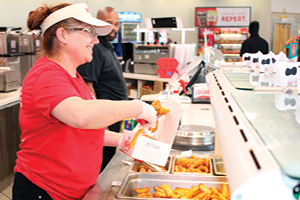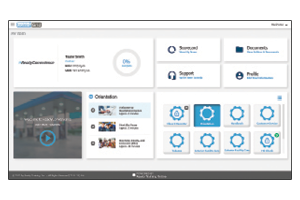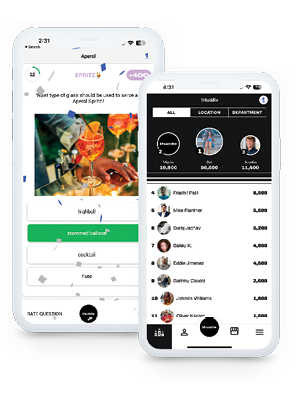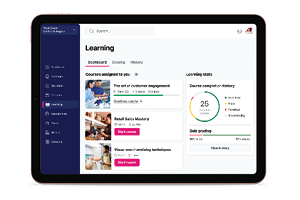More than one-third (36.5%) of full-time associate hires don’t make it through the first 30 days of a convenience store job, according to a study done by the NACS/Coca-Cola Retailing Research Council (NCCRRC).
And while low pay is the top reason hourly employees cite for leaving the job, according to the NCCRRC, the study also uncovered that the average net promoter score for workers who received both on-the-job and formal training was nearly three times higher than for those who received no training, signaling that employees feel more valued, perceive that they have greater career progression and enjoy their work more when they have the right kind of job training.
“When given opportunities to develop, employees feel seen,” said Sam Caucci, founder and CEO of 1Huddle, a training company based in Newark, New Jersey.
Training is a necessity for any job, but it is particularly essential in the convenience industry, where there are compliance and policy requirements for staff to follow regarding alcohol, tobacco and fuel.
Many convenience stores offer their training online, mostly via videos and apps. Having all training online has a handful of benefits, like speed, consistency and cost savings. Plus, supervisors can see exactly which modules staff members have completed and send reminders if they need to.
It’s cheaper, faster and easier to work with online training, said Lori Johnson, director of retail training for United Refining Company, which has more than 300 locations. Johnson uses training from Ready Training Online (RTO), a provider of customizable online training content for retailers. Previously, United Refining brought new hires into a classroom setting.
 At High’s, employees benefit from short, video-based training modules.
At High’s, employees benefit from short, video-based training modules.
“Training is ongoing and we were looking for a solution to optimize time, save money and have a good product put out, especially with so many state and federal regulations that have to be met,” Johnson said. “It was a no-brainer how we could save time and money.”
“We’ve been very successful getting a great handle on required certifications—alcohol, tobacco and environmental trainings—even with turnover. Within a few days of someone being hired we can get certain certifications done,” Johnson added.
High’s Stores from Carroll Motor Fuels, a Maryland-based company, are typically only 80% to 90% staffed. That means managers want new hires to start working as quickly as possible. Staff are first trained on the front line, watching videos and then putting the learnings into practice. “You’re learning to be functional on those stations; it’s all blended learning,” said Dallas Wells, vice president of foodservice, training and development.
“If we don’t train people, we don’t keep them.”
“[Managers] have to do it quickly and payroll is at a premium,” said Wells. Employees take the basic training modules during their first days on the job and then the less vital training more gradually.
High’s is also moving toward using more QR codes at stations or on equipment. So if employees are unsure how to use something, they can scan it and immediately learn how to do a task such as using the fryer or cleaning the coffee machine without asking for help. High’s, like United Refining, is a customer of RTO.
Nouria Energy, based in Worcester, Massachusetts, works with PASS Training and Compliance, a company based in Muncie, Indiana “We don’t ever want employees to have to spend too much time doing anything,” said John Collins, regional compliance manager. “Having a program and tool that allows [new hires] to quickly go through the onboarding process and get everything they need without having to jump through a lot of administrative tasks is hugely beneficial.”
Training via PASS videos takes about the same amount of time as traditional training, Collins said, but employees “come out with exponentially more knowledge. It’s taken a lot of work away from the store.”
Modern Day Retention
Learning through technology is not only faster, but it also engages today’s workers, especially younger ones.
RTO’s initial training lasts around 90 days, but the company has ongoing training which helps keep staff in their jobs, said RTO President and CEO Jeff Kahler.
“It’s about making it an immersive experience and showing the new hire that there’s a career path,” said Kahler.
 Ready Training Online’s training dashboard for employees.
Ready Training Online’s training dashboard for employees.
That ongoing training is crucial to retention. High’s send out refresher trainings to employees, like if it’s rolling out a new sandwich for example. It will send a link to every designated employee so they can watch the video and brush up on their skills or learn how to make the new item. Supervisors can check they’ve completed the training and send reminders if they haven’t.
Refresher trainings can also help minimize liability if there’s a problem, such as an oil spill or alcohol sold to a minor. “When you present training records in court, it can really help,” said Wells.
United Refining employees take legal training in their first few hours on the job, then complete the remainder over the next 10-15 days or within the month. The training is scheduled, for example, in the first two hours of a six-hour shift. But United Refining employees must also complete ongoing refresher training modules on topics like sexual harassment. Some are taken every six months and some every year.
From the employee side, “If we don’t train people, we don’t keep them,” said Nouria’s Collins. “No team member wants to be in an environment where people don’t invest in them and give them skills. They don’t want to be in a position where they don’t know what to do.”
“Microlearning is where it’s headed.”
Short Bursts
RTO’s training videos are getting shorter, with an ideal time of less than five minutes. “Microlearning is where it’s headed,” Kahler said.
To keep things short and sweet, RTO breaks topics into shorter sections. So instead of combining sweeping and mopping a floor under one broad cleaning training, they become two separate modules.
PASS recently recreated its associate training “to make it more concise with less content per slide,” said Raymond Rees, president and CEO. “When we deliver video content, it’s short bursts.” PASS tries to keep each training video under 30 seconds, but some go as long as a minute. Often trainings are grouped into chapters with four or five sections, so an employee will watch or listen to them all and then take a quiz.
Zipline, a training company based in San Francisco, agrees that shorter is better. “Instead of a 10-minute video, we’ll split it into one- or two-minute chunks, then have a knowledge check at the end,” said Emily Lane, head of content. “Employees retain it better that way.”
 1Huddle offers training with games, which helps employees remember what they’re learning.
1Huddle offers training with games, which helps employees remember what they’re learning.
Bite-sized pieces of information are key so employees can fit them in around their work, she said. “It’s more realistic if they can do it in little pieces. Staffing is a challenge and people are pulled in many directions. There’s a higher likelihood that it will get done if it’s shorter, and there’s better retention. So you can chip away at it when you have a few minutes.”
Training via gif is the ultimate quick learning method, and Lane said employees use gifs for very quick bites of information, like how to attach something to something else, for example. “With one click employees can get more detail,” she explained.
Younger employees especially prefer short videos and retain the information better when it’s presented this way, said Nouria’s Collins. “Making the training short makes it more digestible and easier for them to find five minutes now and then 10 minutes later, rather than 45 minutes [at once].”
He added, “If we dump a lot of information on them, what are the odds they’re going to remember it? So breaking it down really helps.”
Game Day
Learning via games is becoming more popular within retail.
Around 35% of RTO’s content has been converted to include interactive elements or gamification, which Kahler said really helps people retain the information learned.
Games work because they engage staff members, said 1Huddle’s Caucci. Games can also lead to healthy competition among employees via leaderboards, where they are not only learning but looking to out-compete their colleagues. This can be great for team building, Caucci explained. “It makes you feel like you belong.”
 Zipline’s training dashboard for employees.
Zipline’s training dashboard for employees.
And at the end of the day, games are fun, which can also help with retention. “I don’t know why so many companies think fun is bad,” said Caucci. “Play is a powerful tool and makes the learning stickier. And the absence of play is rote work. And that mode isn’t working anymore.”
1Huddle also rewards employees who do well and allows them to rack up rewards when they win games, such as a $5 gift card. “The intrinsic rewards around recognition are more powerful and lasting. A good game should show your status, your rank, your progress. You should be offering digital rewards that can be stacked up and an employee can accumulate them,” said Caucci.
Practical Learning
RTO’s video training does not exist in a vacuum. Once staff members have watched a video, they then perform the task and a supervisor watches. “This allows the learner to get some real-life experience while also seeing some examples of what they have just learned,” Kahler said.
Putting videos into practice is also a goal for Zipline. Employees can watch the videos when they have a free minute or two, and then can immediately test out their skills. This is very practical, said Lane, since it eliminates the need for managers to pull employees into a back room for training.
“The best way to retain knowledge is to do it in the flow of work,” Lane said. If employees need to know how to do something while working, they can pull up a video, watch it, then put it into action.
At the end of the day, games are fun, which can also help with retention.
Personalized Training Products
Personalizing training materials to the specific store “helps with employee buy-in,” Kahler said, noting that RTO’s videos are filmed in a mock convenience store at RTO’s studio, where retailers can customize content with logos, products and people wearing the appropriate uniforms.
High’s films its food training videos at RTO’s studio and personalizes the content because the retailer has unique items with specific instructions. Wells himself has written the scripts for more than 100 modules.
With 1Huddle’s games, retailers can select a basic game from more than 2,500 options and 1Huddle’s AI tool will create a personalized game for that c-store.
Zipline can also personalize video training for retailers, said Lane. “Training isn’t just about upskilling your workforce. It’s also a valuable opportunity to remind employees of your brand story and values,” she explained.